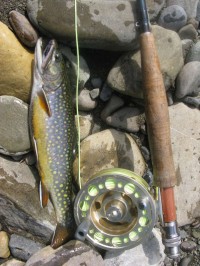Vacation. That word conjures up a lot of images for folks. Thrilling descents on roller coasters, cotton candy, and shaking hands with Micky Mouse. Luxurious cruise ships docked in distant, exotic ports. Fine wine, elegant dinners for two, gawking at Picasso paintings, and falling in love with the Manhattan skyline. The list of choices for Americans away from work is endless. In my fifty-six years of life (nearly thirty-four working full-time) I’ve enjoyed my share of memorable respites from the daily grind. This week, I spent three days of a week off from work on Minnesota’s North Shore (that’s on Lake Superior for you non-Minnesotans) with my youngest son, Jack. He’s thirteen: the perfect age to learn how to fish the craggy, rocky streams of NE Minnesota for the wild and beautiful fish that is my favorite: Salvelinus fontinalis; the eastern brook trout (actually members of the char family and not true trout). So, with about a week of foresight, I planned a trip to my favorite stream on the Shore along with some side visits to small lakes tucked in the wilderness above the Sawtooth Mountains.
In the past, I’ve taken my older sons brook trout fishing. The streams I fish are not gushing, rushing, torrents of water like you envision after watching movies about trout fishing, like “A River Runs Through it”. Generally, what we’re working, when we trout fish the North Shore, are tiny little rivulets and brooks with the occasional modest stream thrown in for good measure. And, while I recognize that purists will balk at what I am about to say (think of the drunk movie star in “A River Runs Through It”), though I’ve tried my hand at fly fishing and I understand its poetry, I am, through and through, a worm man. That’s right: I fish for these beautiful bursts of color and energy with sinker, hook, and dew worm. I know, I know. It’s not as lyrical. It’s not what Ike Walton would do. Too bad. I only get out once a summer to pursue the brookies. I want to ensure at least a few fish, my favorite eating fish, for the frying pan. Worms ensure dinner. It’s that simple. It’s something Ernest Hemingway knew and applied when he fished for trout in the streams of his beloved Michigan.
Tuesday morning. We are up at the crack of dawn and, after a brief stop at the Two Harbors McDonald’s for breakfast on the fly, we’re back on the road. The old Pacifica handles the eighteen-foot Grumman square stern on the roof racks without a hitch. The cargo space of the van is loaded with a two-horse Honda four-stroke, gas, camping equipment, fishing equipment, food, and other supplies. Jack sits in the passenger seat and eats his McGriddle as I munch on an egg McMuffin. When we arrive at Tettegouche State Park just outside of Silver Bay, I’m apprehensive: We’re way too early for the 4:00pm check-in.
Now, you’d think a guy who wrote the book on the formation of Tettegouche State Park (see Mr. Environment: The Willard Munger Story) would have used and appreciated Minnesota’s 76 state parks (nearly one for every county in the state!) before he turned fifty-six years old. Not so. This is my first overnight stay in a Minnesota state park so I’m a bit apprehensive that my online reservation was messed up. Nope. Turns out making a reservation over the Internet worked out fine and dandy. And, because the folks ahead of us have already vacated the spot, we’re allowed to set up early. After a flurry of activity, we get back in the Pacifica and hit the road in search of trout.
When we arrive at the water’s edge, the day is too nice to be a good trout fishing day but we’ve come too far not to fish. We split up: Jack heading downstream and I upstream, our rods and a stockpile of worms, hooks, and sinkers in hand.
“Fish the edges of the fast water, at the ends of little rapids. The fish will be hiding there with the sun up like it is,” I say.
“OK, Dad.”
It’s high noon and there are no clouds in the sky. I dip my hand in rushing water: It’s cold, no more than 65 degrees, perfect for brook trout. But the sun being so high will be a problem. Still, a bad day on the river is better than any day in the office.
The river we’re on (really a stream but bearing the regal title of “river”) has the worst rocks for walking I’ve ever encountered. I stumble and bumble my way upstream, tossing my hook and worm from my fly rod into any water that looks trouty. I have one good strike but, given it’s been three years since I fished brookies, my reactions are slow and I miss the fish. I look back down river and see Jack has already tangled his line in a tree. I don’t offer any suggestions: At thirteen, he’s a veteran fisherman. I know he’ll figure it out.
The day progresses. I get lost in the rhythm of tossing worms under rocks, cut banks, downed trees, cedar boughs, and the like. It takes awhile but I finally find fish. Lots of fish. Nice ones too. The largest I take are twelve inches or so. I catch a couple of that size, big fish for this little water. The feel of a brookie on the hook hasn’t changed despite the distance of time: When I feel the line tighten and the slack start running against the current, I know what to do. I set the hook and the fight is on. The little char fight like the dickens and dance across the silver water into my hand. I lose a few. Catch a few dozen. I lose track of time but, in a moment of parental concern, realize that the predicted storm is at hand: Thunder is rumbling in the distance and a gray blanket is seeping into the valley. I begin my walk back downstream, the fish pouch of my fly vest full of fat, shimmering trout. Enough for dinner tonight and tomorrow night. Not paying attention and in a rush to make it back to the car, I stumble and fall a half-dozen times.
“Should have brought a walking stick,” I mutter as I examine my ring finger above my wedding band which now is twisted in a direction I’ve never seen it before.
I land on my rump, my knees, my shins. I’m wearing tennis shoes and bluejeans: I learned long ago that waders are an inconvenience in these streams: They are hot and ungainly and totally unnecessary for the waters we’re working.
“How did you do?” Jack asks when we meet up where I’d left him.
“Lots of fish,” I reply.
“Where were you, Dad? I started up the river to find you but gave up. You must have been a mile upstream.”
“I was.”
Jack is as wet and dirty as a thirteen-year-old can be.
“Get any fish?” I ask.
“Chubs. Hundreds of chubs.”
I smile as we walk up the hill towards the waiting Pacifica. The sky rumbles with renewed insistence.
“I’d better clean the fish. You pack the stuff away. It’s gonna pour.”
I hand Jack my rod and my fishing vest, dig into the tackle box, and remove a fillet knife.
“Chubs, eh? You were in slow water. You need to find the fast stuff on hot days like today.”
Jack doesn’t seem the least bit disappointed.
“One of them was this long,” he says, making a gap between his hands that’s at least a foot across.
“Too bad we can’t eat chubs,” I quip.
I squat near the stream and clean the fish. The yellow, blue, and red spots have faded as the life has left the brookies but they remain the most striking fish an angler can pursue in Minnesota. They are pallets of color and, on hook and line, the most robust of fighters for their size. By the time I’ve packed the gutted fish in a plastic bag and put them on ice in the cooler, the storm arrives and engulfs the Pacifica in a wall of cool rain as we drive back to Tettegouche.
We clean up a bit at the campground shower building before clambering into the tent. Rain continues to fall by the bucket. Our tent stays dry. I turn on our battery powered lantern intent upon reading while we wait for the rain to let up.
“How about a story?” I ask.
“Sure,” Jack says, his head resting on his pillow, his eyes shut.
I pull out Up North by Duluth outdoor writer, Sam Cook, and search for a fishing story. I hit gold.
“This one’s called, ‘The Trout Fisherman’.”
“Cool.”
At first it looked like a trail, not a worn path, but a meandering opening among the thimbleberries. The trail dissolved into forest, but that didn’t bother Enok Olson. Now he was coursing randomly through the aspen and large-leafed aster, stepping over deadfalls, and batting branches away from his face.
It didn’t seem that he was trying to find the stream so much as he was being drawn to it. Perhaps that’s the way it is when you’re almost 89, and brook trout streams have been drawing you to their banks for half a century…
“That was an awesome story,” Jack says as the storm lets up and we make ready to leave the tent and fry up the trout for dinner.
As I unzip the wet rain fly, I think about Enok Olson.
I hope that if I make it to 89 and I fall on my rump in a North Shore brook trout stream, I have the gumption to get back up.
Peace.
Mark
(Excerpt from Up North (c) Sam Cook, 1986)



